高考英语谓语动词考点清单讲解课件(88张PPT)
文档属性
| 名称 | 高考英语谓语动词考点清单讲解课件(88张PPT) |  | |
| 格式 | zip | ||
| 文件大小 | 4.8MB | ||
| 资源类型 | 教案 | ||
| 版本资源 | 通用版 | ||
| 科目 | 英语 | ||
| 更新时间 | 2022-07-27 21:28:39 | ||
图片预览

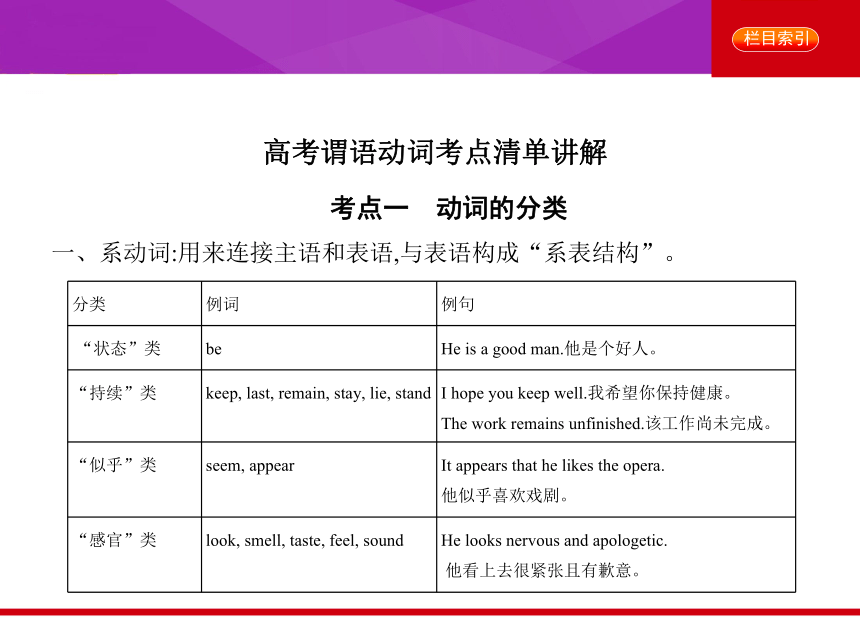
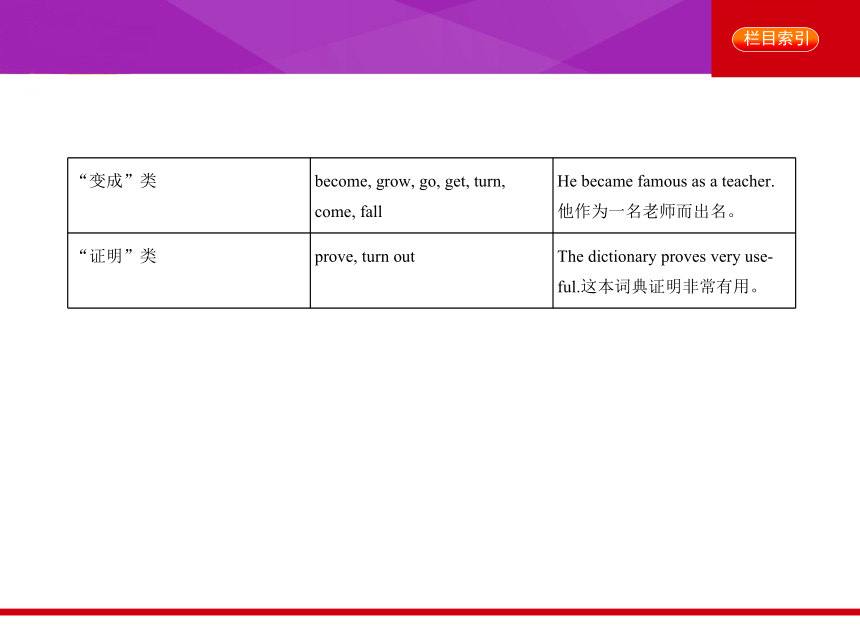
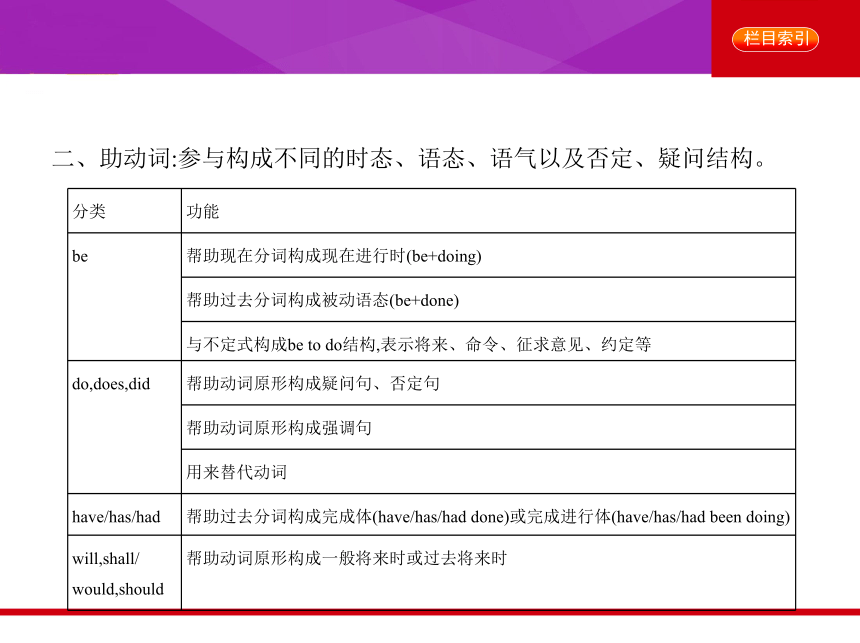
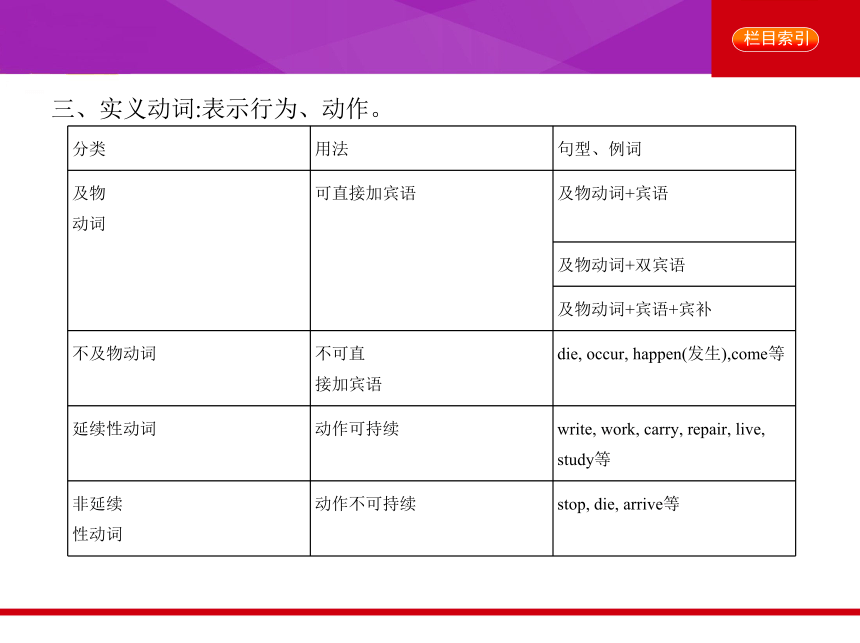
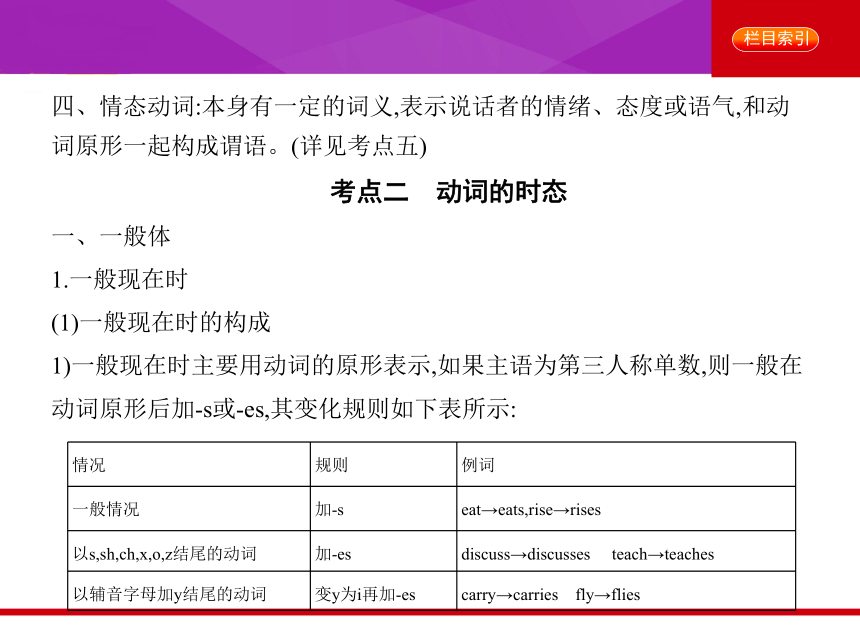
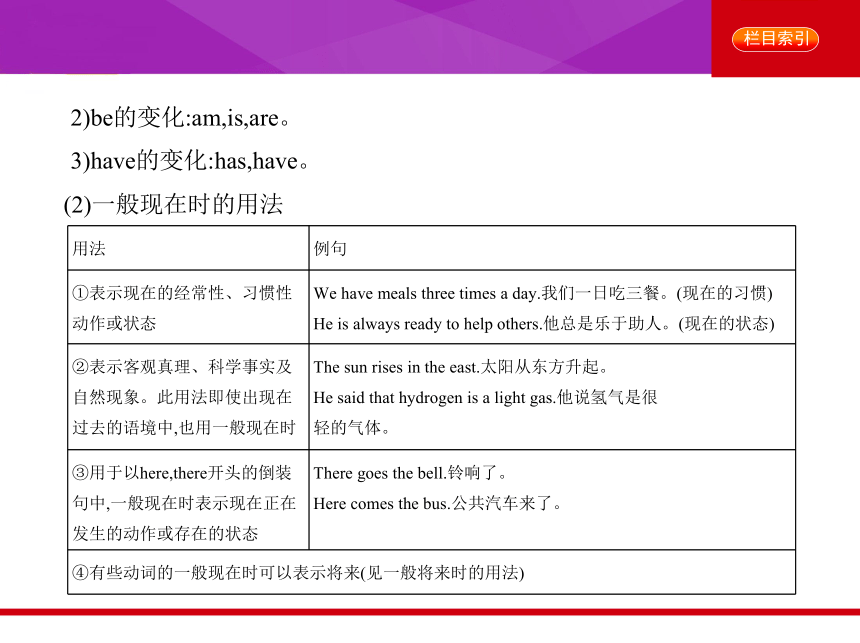

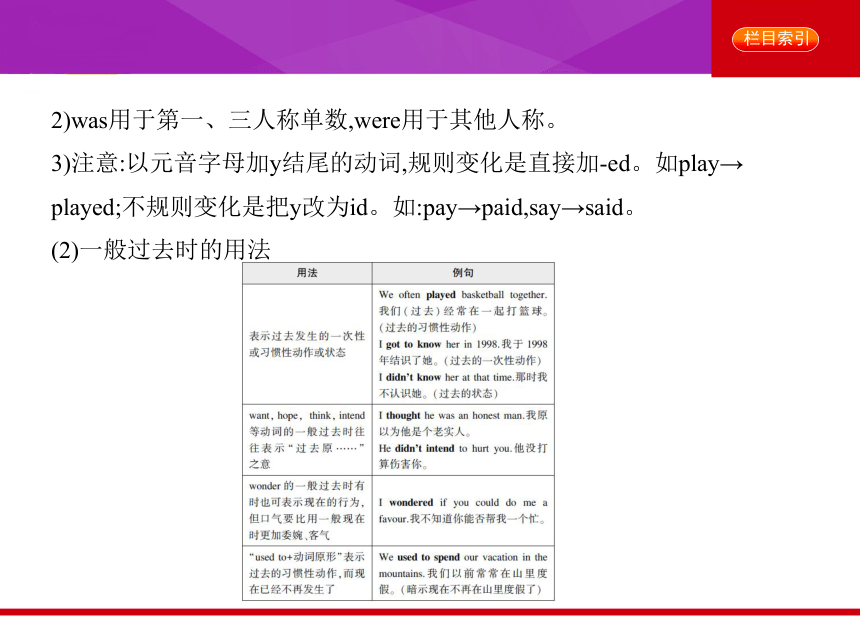
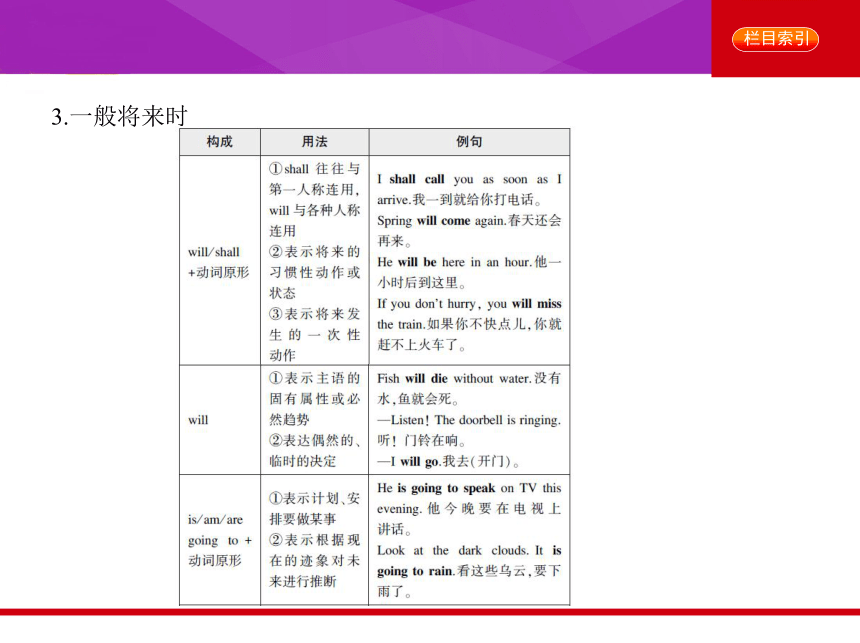
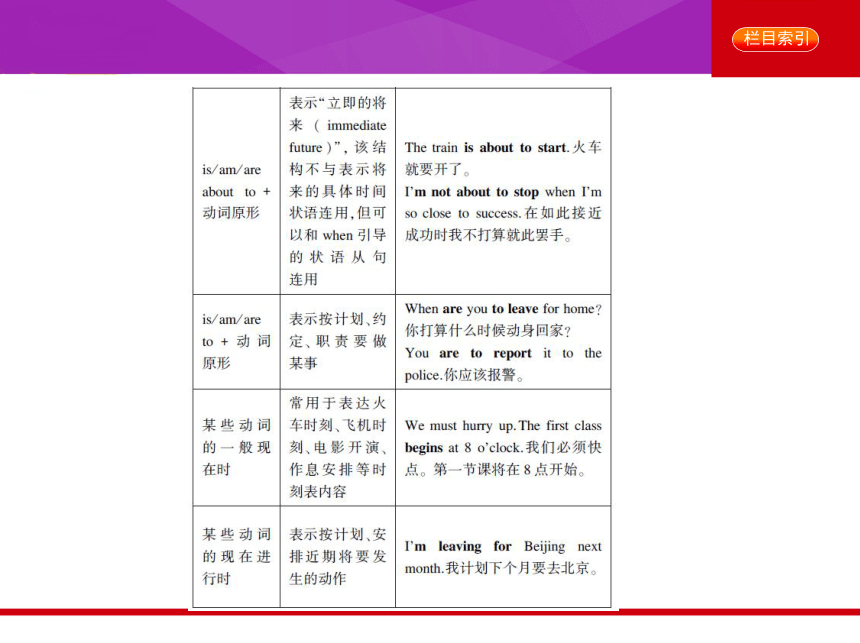

文档简介
(共89张PPT)
高考英语谓语动词考点归纳·最新
考点一 动词的分类
一、系动词:用来连接主语和表语,与表语构成“系表结构”。
高考谓语动词考点清单讲解
分类 例词 例句
“状态”类 be He is a good man.他是个好人。
“持续”类 keep, last, remain, stay, lie, stand I hope you keep well.我希望你保持健康。
The work remains unfinished.该工作尚未完成。
“似乎”类 seem, appear It appears that he likes the opera.
他似乎喜欢戏剧。
“感官”类 look, smell, taste, feel, sound He looks nervous and apologetic.
他看上去很紧张且有歉意。
“变成”类 become, grow, go, get, turn,
come, fall He became famous as a teacher.
他作为一名老师而出名。
“证明”类 prove, turn out The dictionary proves very use-
ful.这本词典证明非常有用。
二、助动词:参与构成不同的时态、语态、语气以及否定、疑问结构。
分类 功能
be 帮助现在分词构成现在进行时(be+doing)
帮助过去分词构成被动语态(be+done)
与不定式构成be to do结构,表示将来、命令、征求意见、约定等
do,does,did 帮助动词原形构成疑问句、否定句
帮助动词原形构成强调句
用来替代动词
have/has/had 帮助过去分词构成完成体(have/has/had done)或完成进行体(have/has/had been doing)
will,shall/ would,should 帮助动词原形构成一般将来时或过去将来时
三、实义动词:表示行为、动作。
分类 用法 句型、例词
及物 动词 可直接加宾语 及物动词+宾语
及物动词+双宾语
及物动词+宾语+宾补
不及物动词 不可直 接加宾语 die, occur, happen(发生),come等
延续性动词 动作可持续 write, work, carry, repair, live,
study等
非延续 性动词 动作不可持续 stop, die, arrive等
词原形一起构成谓语。(详见考点五)
考点二 动词的时态
一、一般体
1.一般现在时
(1)一般现在时的构成
1)一般现在时主要用动词的原形表示,如果主语为第三人称单数,则一般在
动词原形后加-s或-es,其变化规则如下表所示:
四、情态动词:本身有一定的词义,表示说话者的情绪、态度或语气,和动
情况 规则 例词
一般情况 加-s eat→eats,rise→rises
以s,sh,ch,x,o,z结尾的动词 加-es discuss→discusses teach→teaches
以辅音字母加y结尾的动词 变y为i再加-es carry→carries fly→flies
(2)一般现在时的用法
用法 例句
①表示现在的经常性、习惯性动作或状态 We have meals three times a day.我们一日吃三餐。(现在的习惯)
He is always ready to help others.他总是乐于助人。(现在的状态)
②表示客观真理、科学事实及自然现象。此用法即使出现在过去的语境中,也用一般现在时 The sun rises in the east.太阳从东方升起。
He said that hydrogen is a light gas.他说氢气是很
轻的气体。
③用于以here,there开头的倒装句中,一般现在时表示现在正在发生的动作或存在的状态 There goes the bell.铃响了。
Here comes the bus.公共汽车来了。
④有些动词的一般现在时可以表示将来(见一般将来时的用法)
2)be的变化:am,is,are。
3)have的变化:has,have。
2.一般过去时
(1)一般过去时的构成
1)一般过去时用动词的过去式表示,其规则动词变化方法如下表所示:
情况 规则 例词
一般情况 加-ed pack→packed
以辅音字母加y 结尾的动词 变y 为-ied carry→carried
以一个辅音字母结尾 的重读闭音节动词 双写辅音字 母加-ed plan→planned
以不发音的e 结尾的动词 直接加-d like→liked
provide→provided
played;不规则变化是把y改为id。如:pay→paid,say→said。
(2)一般过去时的用法
2)was用于第一、三人称单数,were用于其他人称。
3)注意:以元音字母加y结尾的动词,规则变化是直接加-ed。如play→
3.一般将来时
4.过去将来时
题组训练·单句填空
①They live (live)in the same building, don't they
②I promise I will support (support)you all the time.
③The plane takes (take)off at 8:00 a.m.
④I hoped I would find (find)a job soon.
二、进行体
1.进行体的构成
(1)考纲对进行体所要求掌握的时态:现在进行时、过去进行时、将来进行
时,它们的构成形式分别为:
现在进行时:am/is/are+现在分词
过去进行时:was/were+现在分词
将来进行时:will/shall+be+现在分词
(2)现在分词的构成形式:
情况 规则 例词
一般情况 加-ing try→trying
以一个辅音字母结尾 的重读闭音节动词 双写辅音字 母加-ing regret→regretting
ban→banning
以不发音的e 结尾的动词 去掉e, 加-ing hate→hating
date→dating
用法 例句
表示某一时刻正在进行的动作或存在的状态,具
有暂时性和未完成性的特点 I didn't really work there;I was just helping out un-
til the new secretary arrived.我并不在那里上班,我
只是去帮忙。新秘书来了,我就离开了。(暂时
性)
表示某阶段正在进行的动作或发生的事情,常与
these/those days,this/that week等时间状语连用 We are making model planes these days.
这些天我们在做飞机模型。(此时此刻不一定在
做)
表示赞赏、厌恶、遗憾等情绪,常与always, con-
tinually,constantly,forever,all the time等连用 He is always thinking of others first.他总是先想到
他人。
有些动词的进行时可以表示将来(见一般将来时的用法)
2.进行体的用法
3.有些动词不用于进行体,常见的有:
题组训练·单句填空
⑤Sorry, you can't use my computer. I am using (use)it now.
⑥I was watching (watch)TV when you rang me up.
⑦At this time tomorrow, I will be sitting (sit)at the table.
分类 例词
感觉类 look,smell,feel,sound,taste,see, hear
情感类 like,love,prefer,admire,hate,fear,adore
心态类 wish,hope,want,need,believe, understand, remem-
ber,forget, agree,know
状态类 appear,lie(位于), remain,belong to, have
(一)完成体的构成
[温馨提示]
(1)规则动词的过去分词的构成方法同过去式的构成方法,详见一般过去时
部分“规则动词变化方法”。
(2)不规则动词的过去分词构成详见“附录二”(不规则动词表)部分。
时态 形式
现在完成时 have/has+过去分词
过去完成时 had+过去分词
将来完成时 will have+过去分词
三、完成体
用法 例句
表示一个动作开始于过去,持续到现在(甚至到将
来)。常与之连用的时间状语有:lately,recently, in
the last(past)few days/years,since then,up to now,
so far(到目前为止)等 In the past few years, great changes have taken
place in my hometown.在过去的几年里,我的家乡
发生了巨大变化。
He has written 8 books so far.到现在为止,他已经
写了8本书了。
表示过去发生的事情对现在产生的影响。说话
者中心在现在,常用的状语有:already,ever,just(刚
刚),yet,before等 He has turned off the light.(=The light is off now.)
他已经关掉灯了。
The concert has already started.(=The concert is on
now.)音乐会已经开始了。
(二)完成体的用法
1.现在完成时
在“最高级+名词”或“It/This is+the+序数词+
time”之后的从句中谓语动词常用现在完成时 This is the first time(that)I have come here.这是我
第一次来这里。
This is the best tea(that)I have ever drunk.这是我
喝过的最好的茶了。
have gone to意为“去某地了”,表示此人现在还
在那里 He has gone to the zoo.他去动物园了。
He has gone to live abroad.他到国外居住了。
have been to意为“去过某地”,表示此人已经回
来了 Have you ever been to Shanghai 你去过上海吗
He has been to see his teacher.他去看过他老师
了。(已经回来)
瞬间动词可以用于完成时态,但不可以接表示一
段时间的状语 (√)He has finished his work.
(×)He has finished his work for an hour.
[温馨提示]
(1)瞬间动词用于现在完成时且与表示一段时间的时间状语连用时,需在谓
语动词、时态或句型方面作相应变化。如:
他参军3年了。
(×)He has joined the army for 3 years.
(√)He has been in the army for 3 years.(变换动词)
(√)He joined the army 3 years ago.(变换时态)
(√)It has been/is 3 years since he joined the army.(变换句型)
汉语意思 瞬间动词(词组) 延续性动词(词组)
买 buy have
借 borrow keep
结婚 get married be married
认识 get to know know
离开 leave be away
回来 come back be back
生病 fall ill be ill
死亡 die be dead
(2)部分瞬间动词(词组)与延续性动词(词组)对应表
关闭 turn off be off
打开 turn on be on
动身 leave for be off to
返回 return be back
变成 become be
开始 begin be on
睡觉 go to bed sleep
穿 put on wear/have on
来/去 come/go be in/away
参加 join be a member of
感冒 catch a cold have a cold
入睡 go to sleep/fall asleep be asleep
到达 get to/arrive in(at)/reach be in
用法 例句
一件事情发生在过去,而另外一件事情先于它发
生(即表“过去的过去”),那么发生在前的动作
要用过去完成时 She had learned some English before she came to
the institute.她在来这个机构前已学过一些英语
了。
He said that he had been abroad for 3 years.他说他
在国外待了3年。
表示从过去某一时间开始,一直延续到过去的另
一时间的动作,常用的时间状语有:by/until/before
/by the end of+“表过去的某一时间” By then he had learned English for 3 years.到那时,
他已学了3年英语了。
Until then he had known nothing about it yet.到那
时为止,他对此仍一无所知。
hope,expect,mean,intend,want,suppose 用于过去
完成时表示过去未曾实现的愿望或意图 I had hoped to see more of Shanghai.我本希望在
上海多看看。(但未能如愿)
2.过去完成时
在“Hardly/Scarcely/Barely...when...”和“No
sooner... than...”句型中,when和than 从句用一般
过去时,主句用过去完成时,且用倒装,表示“刚
刚……就……” Hardly/No sooner had I got home when/than the
rain poured down.我刚到家,就下起了倾盆大雨。
在“It was/had been+一段时间+since 从句”中
since从句的谓语用过去完成时 It was ten years since we had had such a wonderful
time.我们有10年没那么高兴过了。
在“That/It/This was the first/second...time+that
从句”句型中,that 从句的谓语要用过去完成时 It was the third time(that)he had made the same
mistake.那是他第三次犯同样的错误了。
3.将来完成时
将来完成时表示到将来某一时间某一动作将会完成,常用的时间状语为
“by+将来的某个时间”。
By this time of next year,all of you will have become college students.
到明年的这个时候,你们大家就都成为大学生了。
题组训练·单句填空
⑧Happy birthday! By this time of next year, you will have turned (turn)18.
⑨I had thought (think)you would come the next day,but you didn't.
⑩This is the first time that he has passed (pass)the exam.
Hardly had (have)we started when the car got a flat tyre.
1.考纲对完成进行体所要求掌握的时态为现在完成进行时,其形式为:have/
has+been+doing。
2.现在完成进行时的用法
用法 例句
动作发生在过去,持续到现在且现在还在进行 He has been learning English for 6 years.他学英语
已经6年了。(强调到现在还在学)
现在完成进行时是现在完成时和现在进行时的
组合,因此,它既具备现在完成时的特征,又具备
现在进行时的特征,如:它具备进行体的“未完
性、暂时性、感彩”的特点 It has been raining for 3 days.已经下了三天雨
了。(强调说话者“抱怨”的感彩)
四、完成进行体
用法 例句
所谓“主将从现”,即主句表将来(不一定为一般
将来时,祈使句、“情态动词+动词原形”也可
表将来),从句(包括时间、条件、让步状语从句)
用现在时(不一定是一般现在时,现在进行时、现
在完成时也可在这类从句中表示将来) Whatever you say,I will not change my mind.无论
你说什么,我都不会改变主意。
If she is still waiting,tell her to go home.如果她还
在等,就让她回家。
I will go with you as soon as I have finished my
work.我一做完工作就和你一起去。
五、动词时态的呼应
1.主将从现
2.含宾语从句的句子的时态一致问题
(1)宾语从句中的动词时态常受主句谓语时态的制约,如果主句谓语为现在
时或将来时,宾语从句中的谓语可以不受影响。
He says (that)
(2)如果主句的谓语动词是过去时,宾语从句的谓语动词一般需用过去的某
种时态,即一般过去时、过去进行时、过去完成时、过去完成进行时、过
去将来时、过去将来进行时等。如:
注意:(1)当主句为过去时,宾语从句有明确的表过去的时间状语时,可不必
用过去完成时而用一般过去时。
I knew he was born in 1991.我知道他生于1991年。
(2)当宾语从句表达真理时,谓语动词不必变为过去时,而继续采用一般现
在时态。
This proved that the earth is round.这证明地球是圆的。
题组训练·单句填空
The teacher told us that the Yangtze River originates (originate)in
Qinghai.
He said he was leaving/would leave (leave)a few days later.
用法 例句
在“would/should/ought to/could/might/needn't/
would like to...have done sth.,but...”句型中,but后
面的谓语动词需用一般过去时或过去进行时 He should have turned up but he had an unexpected
visitor.
他本应该到场,但他有位不速之客。
在“But for the fact+that从句”中,that从句的谓
语动词时态要根据后面句子谓语动词所表示的
时间而定 But for the fact that he is busy now,he would be
here.要不是他现在很忙,他就在这里了。
It is(high)time+that从句,that从句中谓语动词需用
一般过去时或should+动词原形 It is time that we went/should go to bed.我们该睡
觉了。
3.含虚拟语气的句子中的时态一致问题
题组训练·单句填空
But for the fact that you were (be)ill,I would have had you print the pa-
pers.
It is high time that we had/should have (have)lunch.
I would have picked you up at the airport,but I was having (have)a
meeting then.
六、易混时态的区别
1.一般过去时和现在完成时的用法区别
一般过去时所表示的一个或一段过去时间是可以具体确定的,与其他时间
没有牵连,它所表示的事情纯属过去;现在完成时说的是现在的情况。比较
下面几组句子,体会两种时态的不同:
2.一般过去时和过去完成时的用法区别
(1)一般过去时是指过去的动作或情况,而过去完成时指在过去的一个动作
或时间之前发生的事。
He had learned 3,000 English words before he came to this school.他来这个
学校之前就已经学了3,000个英语单词。
(2)过去完成时的时间状语常用by或before 引导的短语或句子表示,如by
that time,by the end of,before 2010,by the time+句子(一般过去时)等。
He had finished writing the book by the end of last month.
到上个月月底为止,他已经写完这本书了。
3.过去完成时与现在完成时的用法区别
两种时态都常与表示一段时间的状语连用,但现在完成时表示的是延续到
现在或同现在有关的动作(句中不可有表示过去特定时间的状语),而过去
完成时表示的是在过去某时之前已经完成或延续到过去某时的动作(句中
可有表示过去特定时间的状语)。比较下面的说法:
题组训练·用所给动词的正确时态填空
The reports went missing in 2012 and nobody has seen (see) them since.
I'm calling about the apartment you advertised (advertise)the other
day.Could you tell me more about it
During the last three decades,the number of people participating in physical
fitness programs has increased (increase)sharply.
考点三 动词的语态
一、被动语态
1.主动语态变被动语态的方法
2.被动语态的构成
英语中的及物动词一般都有主动语态和被动语态两种形式。主动语态是
无标记的,而被动语态则是有标记的。被动语态由“助动词be+过去分
词”构成。助动词be随着主语的人称、数和句子的时态、语气的不同而
变化。几种常见时态的被动语态形式见下表:
时 体 现在 过去 将来 过去将来
一般体 is/am/are done was/were done will/shall be done would be done
进行体 is/am/are being
done was/were being
done — —
完成体 have/has been
done had been done (will have been
done) (would have been
done)
完成进行体 — — — —
3.被动语态的用法
[温馨提示]
(1)动词短语在含被动语态的句子中作谓语时,不可丢掉后面的介词或副词。
用法 例句
不知道或没有必要指明动作的执行者 Attention, please! A meeting will be held in the of-
fice at 8:00 a.m. tomorrow.Everyone is expected to
attend on time.请注意!明天上午八点在办公室召
开会议。望大家准时参加。
强调或突出动作的承受者 The woman was taken to hospital.那位女士被送进
了医院。
动作执行者被较长的修饰语修饰 The idea was supported by those who wished to
make much money.想挣许多钱的人们支持那个
主意。
The plan will be given up.这项计划就要被放弃了。
Bad habits have been done away with.坏习惯已经改掉了。
(2)含情态动词的被动语态形式是:情态动词+be+过去分词
He must be prevented from going.必须阻止他去。
The plan ought to be put into practice as soon as possible.
这项计划应该尽早执行。
(3)“get+过去分词”可以表示被动,此结构比较口语化。
The patient got treated once a week.
那位病人一周治疗一次。
He fell off the car and got killed.
他从汽车上掉下来,摔死了。
用法 例句
“系动词look,sound, feel, smell,taste等+形容词/
名词”构成系表结构 The steel feels cold.
钢摸起来很凉。
某些与can't,won't等连用的不及物动词,如open,
shut,move等 The door won't shut.
这扇门关不上。
某些可和well,easily等副词连用的不及物动词,如
read, write,draw,wash,clean,cook等 Nylon cleans easily.尼龙容易洗干净。
Your article reads very well.你的文章读起来很不
错。
少数不及物动词用于进行时,其主动形式表示被
动含义,如print,cook,sell等 The meat is cooking.肉正在炖着。
二、主动形式表被动意义
注意:“介词in,on,under 等+名词”构成介词短语表被动意义。
表示方位或目的的介词与含动作意义的名词合用,含被动之意,其意义相当
于该名词相应动词的被动形式,名词前一般不用冠词。常见的有:
under control 受控制 under treatment 在治疗中
under repair 在修理中 under discussion 在讨论中
under construction 在施工中
beyond belief 令人难以置信
beyond one's reach 够不着 beyond one's control 无法控制
for sale 待售 for rent 出租
in print 已出版 in sight 在视野范围内
on sale 出售 on show 展出
on trial 受审 out of control 失去控制
out of sight 在视野范围外 out of one's reach 够不着
out of fashion 不流行
The rumor is beyond belief(=can't be believed).
那个谣言令人难以置信。
Today some treasures are on show(=are being shown)in the museum.今天一
些珍宝正在博物馆展出。
三、不能用于被动语态的及物动词或动词短语:have(有),wish(希望),cost
(花费),date back to(追溯到),agree with(同意),arrive at/in(到达),shake hands
with(与……握手),succeed in(成功),suffer from(遭受),take part in(参加),
walk into/enter(走进),belong to(属于) 等。
This key just fits the lock.这把钥匙正好开这把锁。
结构中,用不定式的主动形式表示被动含义。
Which driver is to blame for the accident
这次事故是哪个司机的责任
This house is to let.这座房子要出租。
题组训练·单句填空
①If nothing is done (do),the oceans will turn into fish deserts.
②Hundreds of jobs will be lost (lose)if the factory closes.
③A new cinema is being built (build) here.They hope to finish it next
month.
四、在be to blame(该受责备,对某件坏事应负责任)与be to let(待出租)两种
考点四 主谓一致
主谓一致即在句子中谓语动词的数必须和主语的数保持一致。一般
可根据三个原则来确定:
用法 例句
主语是单数,谓语动词用单数;主语是复数,谓语
动词用复数 The results of the research are to be published
soon.研究结果不久将发表。
复合不定代词someone,anyone, everyone, nobody,
something, anything, everything,nothing等作主
语,谓语动词用单数 If anyone sees Lisa, ask her to call me.如果有人看
到莉萨,请她给我打个电话。
Nothing is impossible to a willing heart.世上无难
事,只怕有心人。
each of+ 作主语时,谓语动词用单数形式,但“we, you,
they或名词复数+each”作主语时,谓语动词用复
数形式 Each of the students has an apple.这些学生每人有
一个苹果。(不定代词Each作主语)
The students each have an apple.这些学生每人有
一个苹果。(The students作主语,each作同位语)
一、语法一致
代词all 作主语:若指人,谓语动词用复数;若指事
物或现象,谓语动词通常用单数 All are equal before the law.法律面前人人平等。
All is well that ends well.结局好一切都好。
不定式、动名词或从句作主语时,谓语动词通常
用单数 Having to change trains is a small inconvenience.
换乘火车多少有些不便。
+单数名词 作主语,谓语动词用单数 Many a page in this book is missing.这本书缺了许
多页。
The whole nation is in deep sorrow.整个国家沉浸
在悲痛之中。
题组训练·单句填空
①His suggestion has (have)been accepted.
②To say you were ignorant of the rules is (be)no excuse.
③How to earn daily bread by my pen was (be)then the problem.
用法 例句
形式为单数但意义为复数概念的police,cattle等
作主语时,谓语动词用复数 The police have not made any arrests. 警方未逮捕
任何人。
表示一类人/物的the poor/rich/dead/injured/
wounded等和“the+姓氏复数”作主语时,谓语
动词用复数 The rich are to help the poor.富人应该帮助穷人。
The Greens are going to London.格林一家要去伦
敦。
表示某国人的总称的the Chinese,the British,the
Irish等作主语时,谓语动词用复数 The Chinese are hard-working.中国人民是勤劳
的。
诸如maths,physics,politics,news等以“s”结尾却
表示单数或不可数概念的名词作主语时,谓语动
词用单数 Physics is my favorite subject.物理是我最喜欢的
科目。
Bad news has wings.坏事传千里。
二、意义一致
单复数同形的名词sheep,deer,means,works(工厂)
等作主语,谓语动词的数与实际意义一致 3 sheep are eating grass there.3只羊在那里吃草。
A sheep is lying there.有只羊正躺在那里。
集体名词family,class,crew,team,group,public,au-
dience,committee,crowd,government等作主语时,
谓语动词的单、复数要根据主语所指的意义而
定。当集体名词作为一个整体看待时,谓语动词
用单数;如果指其中各个成员时,谓语动词用复数 The class consists of twenty-five boys and twenty
girls.这个班由25个男生和20个女生组成。(强调
class这一整体)
The class are doing experiments. 全班学生正在做
实验。(强调class里的各个成员)
题组训练·单句填空
④The cattle are (be)eating grass on the hill now.
⑤Not every means is (be)useful.
⑥The English are (be)proud of their sense of humor.
三、就近一致
or, either...or..., neither...nor...,not only...but also...,not...but...在句子中连接
并列主语的时候或者在there be句型中,谓语动词要和离它最近的主语保持
一致。
Not his parents but he doesn't want to go.不是他的父母不想去而是他不想去。
Neither you nor I am wrong.你和我都没错。
Not only the students but also the teacher wishes for a holiday.不仅是学生,老
师也盼望假期。
There is a cup of tea and some apples on the table.桌上有一杯茶和一些苹
果。
题组训练·单句填空
⑦ Are (be)either you or he fit for the job
⑧Not you but I am (be)responsible for this.
⑨ Are (be)not only the students but also their teacher required to attend
the meeting
用法 例句
两个单数可数名词或不可数名词用and连接,表示
两个不同的概念时,谓语动词用复数 Tom and Jack are close friends.汤姆和杰克是亲密
的朋友。
Steam and ice are different forms of water.蒸汽和
冰是水的不同形式。
两个单数可数名词用and连接,表示同一人、同一
物或同一个概念,或表示不可分的整体时,谓语动
词仍用单数 The singer and dancer is to attend our evening par-
ty.那位歌舞演员将参加我们的晚会。
被every,each,many a,no等限定的名词由and连接
时,谓语动词仍用单数 Many a teacher and(many a)student has seen the
film.许多老师和学生看过这部电影。
四、主谓一致的几个难点
1.并列主语的主谓一致
一个单数可数名词或不可数名词被几个用and连
接的并列形容词所修饰时,可以指一件事或几件
事,这种名词作主语,要根据意义一致的原则决定
谓语动词的单复数形式 Simple and plain living is a fine quality.生活简朴
是一种优良的品质。
English and American literature are appealing to
her. 英国文学和美国文学都对她有吸引力。
由and连接的两个what从句作主语时,要根据意义
一致的原则决定谓语动词的单复数形式 What he says and does do not agree. 他言行不一
致。
What he says and does does not concern me.他的
言行与我无关。
在含“名词或代词+with,along with,together with,
as well as,rather than,but,except或not等+名词或代
词”结构的句子中,谓语动词的数应该和第一个
名词或代词保持一致 Tom as well as two of his friends was invited to the
party.汤姆以及他的两个朋友一起被邀请参加聚
会了。
Nobody but one teacher and three students was in
the laboratory.只有一个老师和三个学生在实验
室里。
题组训练·单句填空
⑩Many a good man has (have) been destroyed by drink.
The writer and translator is (be) delivering a speech in our school now.
Tom, not the students, has (have)gone there.
Mary, along with her sisters, attends (attend) the conference regularly.
2.由两部分构成的表示物体的名词,如trousers, pants, jeans,glasses, shoes等
作主语时,谓语动词常用复数形式。但如果这类名词前用了a pair of/two/
three/...pairs of来修饰,谓语动词的单复数往往取决于pair的单复数形式。
That pair of compasses is (be)lost.
3.数词与量词(+名词)作主语时的主谓一致
题组训练·单句填空
Compasses are (be)usually used to draw circles.
用法 例句
表示时间、重量、距离、价格、体积等名词的
复数作主语时,通常被当作整体看待,后接单数谓
语动词 Twenty years is a long time in one's life. 20年在
人的一生中是很长的一段时间。
“分数、百分数、half、the rest或most+of+名
词”作主语时,其谓语动词需与of后的名词保持
一致 About one third of the books are worth reading. 这
些书中大约有1/3值得一读。
但:Two thirds of the population in China are/is
farmers.中国三分之二的人口是农民。
由“kind/form/type/sort/series...+of+名词”作主
语,其谓语动词的形式取决于of前的这些词的单
复数形式 This type of buses is now on show.
(但Buses of this kind are now on show.)现在正展
出这种公共汽车。
A number of students are from the south.不少学生
来自南方。
The number of students from the north is small.来
自北方的学生人数很少。
如果主语由“more than one+名词”构成,尽管从意义上看是复数,但谓语动词用单数形式 More than one student has failed the exam.不止一
个学生考试不及格。
但:More students than one have failed the exam.
a quantity of后既可接复数名词,亦可接不可数名词,这时谓语动词都用单数形式;quantities of后接复数名词、不可数名词,后面的谓语动词都用复数形式 There is a large quantity of milk.有很多牛奶。
A large quantity of books is on sale now.大量图书现在正在销售。
Great quantities of fish were caught on the high seas.在公海上捕到了大量的鱼。
With more forests being destroyed, huge quantities of good earth are being washed away each year.由于越来越多的森林被毁,每年有大量的沃土被冲走。
题组训练·单句填空
Ten years is (be) a moment in history.
A third of his composition has (have) been corrected.
A third of his compositions have (have) been corrected.
Some new forms of art are (be)being discussed at the meeting now.
五、定语从句、强调句型中的主谓一致
1.定语从句中的主谓一致
定语从句中的谓语动词在人称和数方面应该与其先行词保持一致。
I am not the one who is afraid of difficulty.我不是害怕困难的人。
Don't choose me, who am not fit for this job.别选择我,我不适合这个工作。
This is one of the novels that have ever been written by Mo Yan.这是莫言所
写的小说之一。
She is the only one of the girls who sings well in class.她是班里女生中唯一
一个歌唱得很好的女生。
2.在强调句型“It is/was+被强调部分+that/who+其他部分”中,当被强调
部分是句子主语时,“其他部分”中的谓语动词应和被强调的主语保持一
致。
It is I who am a teacher.我才是老师。
It is the boys who are responsible for the accident.是这些男孩应为这次事故
负责。
题组训练·单句填空
He is one of the boys who have (have)helped me.
He is the only one of the boys who has (have)helped me.
考点五 情态动词
一、情态动词概述
1.情态动词的类型
(1)只作情态动词的有:must,can (could),may (might),ought to
(2)可作情态动词也可作实义动词的有:need,dare
(3)可作情态动词也可作助动词的有:shall (should),will (would)
(4)具有情态动词的某些特征的有:have (had) to,used to
2.情态动词的特征
(1)有一定的词义,但不能单独作谓语,它们要和行为动词或连系动词连用,
构成谓语。
(2)适用于主语的各种人称和数 (have to例外,主语是第三人称单数时,要用
has to)。
We/He must work hard.我们/他一定要努力工作。
I have to walk home.我得步行回家。
He has to walk home.他得步行回家。
(3)后面接动词原形,即不带to的不定式 (ought to,have to,used to本身带有
to)。
He may lose his way.他可能会迷路。
You ought to obey the law.你应该遵守法律。
(4)具有助动词的作用,即可用来构成否定句、疑问句及用于简略答语。
—I can't swim. Can you swim 我不会游泳,你会游泳吗
—No, I can't, either.不,我也不会。
用法 例句
①can表示现在一般的能力,could表示过去一般
的能力,即不表示做与未做某事 Mary can speak 3 languages.玛丽能说3门语言。
Tom could sing English songs at the age of 6.汤姆
6岁就能唱英文歌了。
②表示请求、允许。在一般疑问句中could可代
替can,但比can语气更委婉,答语要用can —Can/Could you help me
—Yes, I can.
——你能帮我吗
——可以。
二、情态动词的基本用法
(一)can,could
③can表示具体事情发生的可能,常用于否定句、
疑问句,表示疑惑、惊讶或不相信等意思。can表
示理论上的可能时可用于肯定句。could表示推
测时比can可能性小,可用于肯定句、否定句和疑
问句 That can't be true.那不可能是真的。(具体事情
发生的可能,表示不相信)
Accidents can happen in this weather. 这种天气可
能会发生事故。(理论上的可能性)
It could be weeks before we get a reply. 我们可能
要等好几个星期才得到回复。
④用于固定句型中:can't...too/enough(无论……
也不为过);can't help doing sth./can't help but do
sth.忍不住做某事;cannot but do sth.不得不做某
事 I can't thank him too much.我怎么感谢他也不为
过。
I could not but admire her. 我不得不佩服她。
(二)may,might
用法 例句
①may表示请求或允许,意为:可以。might为may的过去式,常用于间接引语 You may leave the book where it was.你可以把书放在原来的位置。
She said I might call her at the weekend. (间接引语) 她说我可以周末给她打电话。
②may,might 表示推测,用于肯定句,意为“可能”,may not意为“可能不”, 如表达“不可能”则用can't This coat may be Peter's.这件大衣可能是彼得的。
This coat may not be Peter's.这件大衣可能不是彼得的。
③may表示祝愿 May you succeed!祝你成功!
④用于固定句型中:may/might as well do不妨,还是做……为好;may/might well+ do (=be very like-ly to do)很可能 So you might as well do what you love. 所以你不妨做你喜欢做的事情。
Her appearance has changed so much that you might well not recognize her.她的模样变化如此大,你很有可能认不出她了。
(三)must
用法 例句
①表示必要性,意为:必须,其否定式为needn't/
don't have to —Must I give up smoking 我必须戒烟吗
—Yes, you must.是的,你必须。/—No, you needn
't/don't have to.不,你不必。
②mustn't表示:禁止,为may作“可以”讲时的否
定式 You mustn't smoke here.你不可以在这里吸烟。
③表坚持,意为:偏要,非要 Must you make so much noise 你就非得弄出这么
大声吗
④表推断,用于肯定句,意为:一定,准是 You must be tired after your long walk. 你走了那
么长的路,一定累了。
用法 例句
①征求对方意见,与第一、三人称的一般疑问句
连用 Shall I/he go to see you 我/他去看你,好吗
②与第二、三人称的陈述句连用,表示说话者的
意志,用来表达说话者给对方的命令、 指示、允
诺。此种用法还可用来宣布法律、规定 You shall have a new dress for your birthday. 你过
生日一定会有件新连衣裙。
Each competitor shall wear a number. 每位参赛者
都要戴一个号牌。(宣布规定)
(四)shall
(五)should
用法 例句
①(=ought to)意为:应该。既可表示义务上的
“应该”,也可表示推测上的“按道理说应该” You should/ought to be listening.你应该听才对。
(义务上的“应该”)
He should/ought to arrive by now. 现在他按理说
应该到了。(推测上的“按道理说应该”)
②竟然 It's strange that he should be late.真奇怪,他竟然
会迟到。
③用于条件状语从句中。意为:万一 If I should be free tomorrow,I'll come. 万一明天
有空,我就来。
④与表示命令、建议、请求、要求的动词或名词连用
⑤用于表示与将来事实相反的if从句中
用法 例句
①用于各种人称,表示主语的意愿和意志 He will/would take you home.他愿意送你回家。
②与第二人称的一般疑问句连用,表示请求、建
议 Will/Would you go with me 你愿意和我一起去
吗
③用于叙述“真理”,意为:总是 Oil will float on water.油总是浮在水上。
④will用来叙述目前的习惯;would表示过去的习
惯 He would get up early when he lived in the coun-
try.他住在乡下时总是早起。
(六)will,would
(七)need, dare
分类 用法 例句
实义 动词 有人称和数的变化,可用于肯定句、否定句或疑问句中,构成否定句或疑问句时要用助动词do,does, did ①He needn't do it.(情态动词)
②He doesn't need to do it.(实义动词)
③Dare you jump off the high wall (情态动词)
④Do you dare(to) jump off the high wall (实义动词)
⑤He dared not do it.(情态动词)
⑥He didn't dare(to)do it.(实义动词)
⑦Try it if you dare come here. (情态动词)
情态 动词 没有人称和数的变化(dare可以有过去式dared),直接接动词原形,主要用于否定句和疑问句中,构成否定句和疑问句时不用助动词
另外,dare作情态动词时,还可用于条件句中;作实义动词时,dare用于疑问句或否定句,后面的to也可省略;I dare say是习惯说法,意为“我想,大概”
题组训练·单句填空
①Although you can find (find)bargains in London,it is not generally a
cheap place to shop.
②Life is unpredictable; even the poorest may/might become the richest.
③ Can/May/Shall I have a word with you It won't take long.
④The rule states that no child shall be allowed out of the school during
the day unless accompanied by an adult.
情态动词+have done 用法 例句
must have done 想必/准是/一定做了 否定式为:can't/couldn't+have
done It must have rained last night,for
the road is quite muddy.
昨晚一定下雨了,因为路很泥
泞。
can/could have done 1.本来能够做而未做 2.过去可能会做 Can he have gone to his aunt's
他有可能去他姨妈家了吗
cannot/could not have done 1.过去不可能做 2.过去没能够做 He cannot have forgotten it.
他不可能忘了那件事。
(八)“情态动词+have done”用法一览表
may/might have done 也许/或许已经做了,一般只用于
肯定句或否定句中(在否定句中
表示“可能不”),不用于疑问
句,用might则表示语气更加弱 It's too late.I think he may have
gone to bed.
太晚了,我想他或许已经睡了。
He may not have finished the
work.
他也许还没完成那项工作。
should/ought to have done 本该做而实际上未做 You ought to have done this ex-
ercise more carefully.
你本应该更仔细地做这个练
习。
should not/ought not to have done 本不该做而做了 You shouldn't have told her the
truth.
你本不该告诉她真相。
needn't have done 本不必做而做了 You needn't have taken a taxi
here,for it is very near to your
house.
你本来不必打车来这里的,因为
这里离你家很近。
had better have done 当时最好做了(其否定式had bet-
ter not have done表达相反的含
义) You had better not have scolded
her.
要是那时你没责骂她就好了。
would rather have done 宁愿当时做了(其否定式would
rather not have done表达相反的
含义,两者都表示“后悔”之
意) I raised objections at the meeting,
but now I would rather not have
done that.
我在会上提出了反对意见,但现
在我宁愿没那么做。
would like/love to have done 过去愿意做但未做成 I would love to have gone to the
party last night,but I had to work
extra hours to finish a report.
昨晚我本来很想去参加聚会的,
但我得加班完成一个报告。
(九) 几组易混情态(助)动词
1.would,used to
用法 例句
would 表示过去反复的动作,常与every
day, often, frequently等连用 When he was abroad, he would
often read as many books as pos-
sible.在国外时,他总是尽可能多
地读书。
used to 表示过去的状态、习惯,但现在
已经不存在 She doesn't get up so early as
she used to.她不像以前那样起
得那么早了。
用法 例句
could 表示过去的能力,但不表示是否
做 He could ride a bicycle at the age
of 5.五岁时他就会骑自行车
了。
was able to 表示过去有能力并且成功地做
了,相当于managed to do sth. The fire spread very quickly but
everyone was able to get out.火
蔓延很快,但大家都成功地逃了
出来。
could have done 过去本有能力做某事,但没有做 I could have worked out the
problem,but I was too nervous.我
本能够解出那道题,但当时我太
紧张了。
2.could,was able to,could have done
3.must,have to
用法 例句
must 多表示主观需要或责任感驱使
有必要、有义务去做某事,意为:
必须 I must clean the room because it
is too dirty.由于太脏了我必须
打扫房间。
have to 表示由于客观条件、环境所迫
而做某事,意为:不得不 He has to leave school because
he can't afford his schooling.因
为他付不起学费,所以不得不辍
学。
用法 例句
didn't need to do 过去没必要做某事,不强调是否
做 I didn't get up that early yester-
day, for I didn't need to.昨天我
没那么早起床,因为没必要。
needn't have done 过去没必要做某事,但做了 I needn't have got up that early
yesterday but I had to because
the dog barked all the time.昨天
我本不必那么早起床,但是因狗
一直叫,我不得不起床。
4.didn't need to do,needn't have done
5.can't,won't,don't/doesn't
The window won't open.这扇窗户怎么都打不开。(强调实施者执意要打
开)
The window can't open.这扇窗户打不开。(这扇窗户原来设计时就不能打
开。是固定死的)
The window doesn't open.这扇窗户开不开。(强调这扇窗户是坏的,存在质
量问题)
考点六 虚拟语气
一、虚拟语气用于非真实条件句中
从句谓语形式 主句谓语形式 例句
与现在事实相 反 过去式(be动词用were) would/should/could/might+动词原形 If I were you, I would seize the chance.如果我
是你,我就会抓住这个机会。
与过去事实相 反 had+过去分词 would/should/could/might+have+过去分词 If you had taken my ad-vice, you wouldn't
have failed.如果你听了我的建议,你就不会失
败。
与将来 事实相 反 ①过去式 ②should+动词原形③were to+动词原形 would/should/could/might+动词原形 If he shouldn't come tomorrow, we would put
off the meeting.如果他明天不来,我们就推迟
这个会议。
使用虚拟条件句时要注意的几点:
用法 例句
①当条件从句谓语动词表示的动作和主句谓语
动词表示的动作发生的时间不一致时,被称为
“错综时间条件句”,动词的形式要根据它所表
示的时间做出相应的调整 If you had followed my advice, you would be bet-
ter now.如果你听了我的建议,你现在就好多了。
(从句与过去事实相反,主句与现在事实相反)
②在if引导的非真实条件从句中,谓语含were,
had,should,可将if省略,但需将were,had,should提
到主语之前 If I were at school again, I would study harder.→
Were I at school again, I would study harder.如果
我还有上学的机会,我会更加努力学习。
③有时假设的条件并不总是通过if引导的条件从
句表达,而是隐含在某些词、短语或上下文中,此
种句子为“含蓄条件句”,常见的词或短语有:
without,in case, but for, for fear that, otherwise等 Without your help,we couldn't have finished the
work ahead of time.
=But for your help,...= If it had not been for your
help,...=Had it not been for your help,...没有你的
帮助,我们不可能提前完成这项工作。
④even if, even though 也可用于虚拟语气,其形式与if从句在虚拟语气中的形式相同
题组训练·用所给词的适当形式填空
①If he had caught (catch) the morning train, he wouldn't have been late
for the meeting.
②If we had booked (book)a table earlier, we wouldn't be standing here
in the long queue.
条件 从句谓语形式 例句
从句谓语动词与主句谓语动词同时发生 过去式(be动词用were) If only/How I wish I were a fly-ing bird!我多希望我是一只会飞的鸟儿啊!
He looks as if he were an artist.他看上去好像是名艺术家。
二、虚拟语气在wish,if only(=how I wish), as if后的从句中
从句谓语动词先于主句谓语动词发生 had+过去分词 If only I had seen the film!=How I wish I had seen the film!我要是看过那部电影该多好啊!
She speaks English so fluently as if she had stayed in America for a long time.她说英语如此流利,好像她在美国待过很长时间。
从句谓语动词后于主句谓语动词发生 would+动词原形 He learns English so hard as if he
would go to the U.S.A.他如此努
力学习英语,好像他要去美国。
注意:当句子所叙述的是真实的或极有可能发生的或存在的事实时,as if从
句要用陈述语气。
It seems as if it is going to rain.天似乎要下雨。
He walks as if he is drunk.他走起路来像是醉了。
题组训练·用所给词的适当形式填空
③We wish we could (can)fly into space by spacecraft one day.
④She works hard as if she never knew (know)fatigue.
类别 名词性从句谓语动词形式 例句
三、虚拟语气用在主句含“命令、建议、要求”的名词性从句中
一坚持:insist should+动词原形,should可以省
略 He suggested that we(should) start off early the next day.
His suggestion was that we(should) start off early the next day.
It was suggested that we(should) start off early the next day.
他建议我们第二天早点出发。
二命令:order,command
四建议:advise,suggest,propose,recommend
五要求:require,request,demand,desire, urge
注意:suggest作“暗示”讲,insist作“坚持说”讲,由于后面宾语从句谓语
动词不再后于suggest和insist发生,故宾语从句的谓语动词不再使用虚拟语
气形式(should+动词原形),而使用陈述语气。
The smile on his face suggested that he was satisfied with our work.他脸上的
微笑暗示着他对我们的工作很满意。
The man insisted that he had never stolen the money.那个人坚持说他没有偷
钱。
题组训练·单句填空
⑤He urged that a referendum (should) be held (hold)by December.
⑥He gave a proposal that the UN (should)set (set) up an emergency cen-
tre for the environment.
条件 从句谓语形式 例句
对现在或将来的虚拟 过去式(be用were) I'd rather they didn't hear of the
news.我宁愿他们没有听到这个
消息。
对过去的虚拟 had+过去分词 I'd rather I had not told him the
bad news.我宁愿没有告诉过他
那个坏消息。
四、虚拟语气用在“would rather+that从句”中
五、虚拟语气用在“It is (high) time +that从句”中
题组训练·单句填空
⑦It is high time that we talked/should talk (talk)about the problem.
⑧I'd rather you focused (focus)more on your learning now.
六、虚拟语气用在“It is necessary等+that从句”中
在“It is necessary/important/vital/surprising/strange/natural/a pity/essential
等 +that从句”中,that从句的谓语动词用“should+动词原形”,should可以
省略。should表示感彩,意为:竟然。
It is strange that the meeting (should) be put off till next week.那个会议竟然
that从句谓语形式 例句
过去式或“should+动词原形”,且should不能省
略 It is(high)time that you went/should go to school.
你(们)该去上学了。
被推迟到下周,真奇怪。
It is a pity that you (should) have to leave.真遗憾你非得走。
注意:以上句式也可以用于陈述语气。
It's strange that he didn't come yesterday.
It's a pity that you can't dance.
七、虚拟语气用在目的状语从句中
由in case,for fear that,in order that,so that等引导的目的状语从句,其谓语动
词用“could/should/might/would+动词原形”表示虚拟。
They left early for fear that they would meet him.他们动身很早以免和他碰面。
I gave you a map so that you wouldn't get lost!我怕你迷路,给过你一张地图!
高考英语谓语动词考点归纳·最新
考点一 动词的分类
一、系动词:用来连接主语和表语,与表语构成“系表结构”。
高考谓语动词考点清单讲解
分类 例词 例句
“状态”类 be He is a good man.他是个好人。
“持续”类 keep, last, remain, stay, lie, stand I hope you keep well.我希望你保持健康。
The work remains unfinished.该工作尚未完成。
“似乎”类 seem, appear It appears that he likes the opera.
他似乎喜欢戏剧。
“感官”类 look, smell, taste, feel, sound He looks nervous and apologetic.
他看上去很紧张且有歉意。
“变成”类 become, grow, go, get, turn,
come, fall He became famous as a teacher.
他作为一名老师而出名。
“证明”类 prove, turn out The dictionary proves very use-
ful.这本词典证明非常有用。
二、助动词:参与构成不同的时态、语态、语气以及否定、疑问结构。
分类 功能
be 帮助现在分词构成现在进行时(be+doing)
帮助过去分词构成被动语态(be+done)
与不定式构成be to do结构,表示将来、命令、征求意见、约定等
do,does,did 帮助动词原形构成疑问句、否定句
帮助动词原形构成强调句
用来替代动词
have/has/had 帮助过去分词构成完成体(have/has/had done)或完成进行体(have/has/had been doing)
will,shall/ would,should 帮助动词原形构成一般将来时或过去将来时
三、实义动词:表示行为、动作。
分类 用法 句型、例词
及物 动词 可直接加宾语 及物动词+宾语
及物动词+双宾语
及物动词+宾语+宾补
不及物动词 不可直 接加宾语 die, occur, happen(发生),come等
延续性动词 动作可持续 write, work, carry, repair, live,
study等
非延续 性动词 动作不可持续 stop, die, arrive等
词原形一起构成谓语。(详见考点五)
考点二 动词的时态
一、一般体
1.一般现在时
(1)一般现在时的构成
1)一般现在时主要用动词的原形表示,如果主语为第三人称单数,则一般在
动词原形后加-s或-es,其变化规则如下表所示:
四、情态动词:本身有一定的词义,表示说话者的情绪、态度或语气,和动
情况 规则 例词
一般情况 加-s eat→eats,rise→rises
以s,sh,ch,x,o,z结尾的动词 加-es discuss→discusses teach→teaches
以辅音字母加y结尾的动词 变y为i再加-es carry→carries fly→flies
(2)一般现在时的用法
用法 例句
①表示现在的经常性、习惯性动作或状态 We have meals three times a day.我们一日吃三餐。(现在的习惯)
He is always ready to help others.他总是乐于助人。(现在的状态)
②表示客观真理、科学事实及自然现象。此用法即使出现在过去的语境中,也用一般现在时 The sun rises in the east.太阳从东方升起。
He said that hydrogen is a light gas.他说氢气是很
轻的气体。
③用于以here,there开头的倒装句中,一般现在时表示现在正在发生的动作或存在的状态 There goes the bell.铃响了。
Here comes the bus.公共汽车来了。
④有些动词的一般现在时可以表示将来(见一般将来时的用法)
2)be的变化:am,is,are。
3)have的变化:has,have。
2.一般过去时
(1)一般过去时的构成
1)一般过去时用动词的过去式表示,其规则动词变化方法如下表所示:
情况 规则 例词
一般情况 加-ed pack→packed
以辅音字母加y 结尾的动词 变y 为-ied carry→carried
以一个辅音字母结尾 的重读闭音节动词 双写辅音字 母加-ed plan→planned
以不发音的e 结尾的动词 直接加-d like→liked
provide→provided
played;不规则变化是把y改为id。如:pay→paid,say→said。
(2)一般过去时的用法
2)was用于第一、三人称单数,were用于其他人称。
3)注意:以元音字母加y结尾的动词,规则变化是直接加-ed。如play→
3.一般将来时
4.过去将来时
题组训练·单句填空
①They live (live)in the same building, don't they
②I promise I will support (support)you all the time.
③The plane takes (take)off at 8:00 a.m.
④I hoped I would find (find)a job soon.
二、进行体
1.进行体的构成
(1)考纲对进行体所要求掌握的时态:现在进行时、过去进行时、将来进行
时,它们的构成形式分别为:
现在进行时:am/is/are+现在分词
过去进行时:was/were+现在分词
将来进行时:will/shall+be+现在分词
(2)现在分词的构成形式:
情况 规则 例词
一般情况 加-ing try→trying
以一个辅音字母结尾 的重读闭音节动词 双写辅音字 母加-ing regret→regretting
ban→banning
以不发音的e 结尾的动词 去掉e, 加-ing hate→hating
date→dating
用法 例句
表示某一时刻正在进行的动作或存在的状态,具
有暂时性和未完成性的特点 I didn't really work there;I was just helping out un-
til the new secretary arrived.我并不在那里上班,我
只是去帮忙。新秘书来了,我就离开了。(暂时
性)
表示某阶段正在进行的动作或发生的事情,常与
these/those days,this/that week等时间状语连用 We are making model planes these days.
这些天我们在做飞机模型。(此时此刻不一定在
做)
表示赞赏、厌恶、遗憾等情绪,常与always, con-
tinually,constantly,forever,all the time等连用 He is always thinking of others first.他总是先想到
他人。
有些动词的进行时可以表示将来(见一般将来时的用法)
2.进行体的用法
3.有些动词不用于进行体,常见的有:
题组训练·单句填空
⑤Sorry, you can't use my computer. I am using (use)it now.
⑥I was watching (watch)TV when you rang me up.
⑦At this time tomorrow, I will be sitting (sit)at the table.
分类 例词
感觉类 look,smell,feel,sound,taste,see, hear
情感类 like,love,prefer,admire,hate,fear,adore
心态类 wish,hope,want,need,believe, understand, remem-
ber,forget, agree,know
状态类 appear,lie(位于), remain,belong to, have
(一)完成体的构成
[温馨提示]
(1)规则动词的过去分词的构成方法同过去式的构成方法,详见一般过去时
部分“规则动词变化方法”。
(2)不规则动词的过去分词构成详见“附录二”(不规则动词表)部分。
时态 形式
现在完成时 have/has+过去分词
过去完成时 had+过去分词
将来完成时 will have+过去分词
三、完成体
用法 例句
表示一个动作开始于过去,持续到现在(甚至到将
来)。常与之连用的时间状语有:lately,recently, in
the last(past)few days/years,since then,up to now,
so far(到目前为止)等 In the past few years, great changes have taken
place in my hometown.在过去的几年里,我的家乡
发生了巨大变化。
He has written 8 books so far.到现在为止,他已经
写了8本书了。
表示过去发生的事情对现在产生的影响。说话
者中心在现在,常用的状语有:already,ever,just(刚
刚),yet,before等 He has turned off the light.(=The light is off now.)
他已经关掉灯了。
The concert has already started.(=The concert is on
now.)音乐会已经开始了。
(二)完成体的用法
1.现在完成时
在“最高级+名词”或“It/This is+the+序数词+
time”之后的从句中谓语动词常用现在完成时 This is the first time(that)I have come here.这是我
第一次来这里。
This is the best tea(that)I have ever drunk.这是我
喝过的最好的茶了。
have gone to意为“去某地了”,表示此人现在还
在那里 He has gone to the zoo.他去动物园了。
He has gone to live abroad.他到国外居住了。
have been to意为“去过某地”,表示此人已经回
来了 Have you ever been to Shanghai 你去过上海吗
He has been to see his teacher.他去看过他老师
了。(已经回来)
瞬间动词可以用于完成时态,但不可以接表示一
段时间的状语 (√)He has finished his work.
(×)He has finished his work for an hour.
[温馨提示]
(1)瞬间动词用于现在完成时且与表示一段时间的时间状语连用时,需在谓
语动词、时态或句型方面作相应变化。如:
他参军3年了。
(×)He has joined the army for 3 years.
(√)He has been in the army for 3 years.(变换动词)
(√)He joined the army 3 years ago.(变换时态)
(√)It has been/is 3 years since he joined the army.(变换句型)
汉语意思 瞬间动词(词组) 延续性动词(词组)
买 buy have
借 borrow keep
结婚 get married be married
认识 get to know know
离开 leave be away
回来 come back be back
生病 fall ill be ill
死亡 die be dead
(2)部分瞬间动词(词组)与延续性动词(词组)对应表
关闭 turn off be off
打开 turn on be on
动身 leave for be off to
返回 return be back
变成 become be
开始 begin be on
睡觉 go to bed sleep
穿 put on wear/have on
来/去 come/go be in/away
参加 join be a member of
感冒 catch a cold have a cold
入睡 go to sleep/fall asleep be asleep
到达 get to/arrive in(at)/reach be in
用法 例句
一件事情发生在过去,而另外一件事情先于它发
生(即表“过去的过去”),那么发生在前的动作
要用过去完成时 She had learned some English before she came to
the institute.她在来这个机构前已学过一些英语
了。
He said that he had been abroad for 3 years.他说他
在国外待了3年。
表示从过去某一时间开始,一直延续到过去的另
一时间的动作,常用的时间状语有:by/until/before
/by the end of+“表过去的某一时间” By then he had learned English for 3 years.到那时,
他已学了3年英语了。
Until then he had known nothing about it yet.到那
时为止,他对此仍一无所知。
hope,expect,mean,intend,want,suppose 用于过去
完成时表示过去未曾实现的愿望或意图 I had hoped to see more of Shanghai.我本希望在
上海多看看。(但未能如愿)
2.过去完成时
在“Hardly/Scarcely/Barely...when...”和“No
sooner... than...”句型中,when和than 从句用一般
过去时,主句用过去完成时,且用倒装,表示“刚
刚……就……” Hardly/No sooner had I got home when/than the
rain poured down.我刚到家,就下起了倾盆大雨。
在“It was/had been+一段时间+since 从句”中
since从句的谓语用过去完成时 It was ten years since we had had such a wonderful
time.我们有10年没那么高兴过了。
在“That/It/This was the first/second...time+that
从句”句型中,that 从句的谓语要用过去完成时 It was the third time(that)he had made the same
mistake.那是他第三次犯同样的错误了。
3.将来完成时
将来完成时表示到将来某一时间某一动作将会完成,常用的时间状语为
“by+将来的某个时间”。
By this time of next year,all of you will have become college students.
到明年的这个时候,你们大家就都成为大学生了。
题组训练·单句填空
⑧Happy birthday! By this time of next year, you will have turned (turn)18.
⑨I had thought (think)you would come the next day,but you didn't.
⑩This is the first time that he has passed (pass)the exam.
Hardly had (have)we started when the car got a flat tyre.
1.考纲对完成进行体所要求掌握的时态为现在完成进行时,其形式为:have/
has+been+doing。
2.现在完成进行时的用法
用法 例句
动作发生在过去,持续到现在且现在还在进行 He has been learning English for 6 years.他学英语
已经6年了。(强调到现在还在学)
现在完成进行时是现在完成时和现在进行时的
组合,因此,它既具备现在完成时的特征,又具备
现在进行时的特征,如:它具备进行体的“未完
性、暂时性、感彩”的特点 It has been raining for 3 days.已经下了三天雨
了。(强调说话者“抱怨”的感彩)
四、完成进行体
用法 例句
所谓“主将从现”,即主句表将来(不一定为一般
将来时,祈使句、“情态动词+动词原形”也可
表将来),从句(包括时间、条件、让步状语从句)
用现在时(不一定是一般现在时,现在进行时、现
在完成时也可在这类从句中表示将来) Whatever you say,I will not change my mind.无论
你说什么,我都不会改变主意。
If she is still waiting,tell her to go home.如果她还
在等,就让她回家。
I will go with you as soon as I have finished my
work.我一做完工作就和你一起去。
五、动词时态的呼应
1.主将从现
2.含宾语从句的句子的时态一致问题
(1)宾语从句中的动词时态常受主句谓语时态的制约,如果主句谓语为现在
时或将来时,宾语从句中的谓语可以不受影响。
He says (that)
(2)如果主句的谓语动词是过去时,宾语从句的谓语动词一般需用过去的某
种时态,即一般过去时、过去进行时、过去完成时、过去完成进行时、过
去将来时、过去将来进行时等。如:
注意:(1)当主句为过去时,宾语从句有明确的表过去的时间状语时,可不必
用过去完成时而用一般过去时。
I knew he was born in 1991.我知道他生于1991年。
(2)当宾语从句表达真理时,谓语动词不必变为过去时,而继续采用一般现
在时态。
This proved that the earth is round.这证明地球是圆的。
题组训练·单句填空
The teacher told us that the Yangtze River originates (originate)in
Qinghai.
He said he was leaving/would leave (leave)a few days later.
用法 例句
在“would/should/ought to/could/might/needn't/
would like to...have done sth.,but...”句型中,but后
面的谓语动词需用一般过去时或过去进行时 He should have turned up but he had an unexpected
visitor.
他本应该到场,但他有位不速之客。
在“But for the fact+that从句”中,that从句的谓
语动词时态要根据后面句子谓语动词所表示的
时间而定 But for the fact that he is busy now,he would be
here.要不是他现在很忙,他就在这里了。
It is(high)time+that从句,that从句中谓语动词需用
一般过去时或should+动词原形 It is time that we went/should go to bed.我们该睡
觉了。
3.含虚拟语气的句子中的时态一致问题
题组训练·单句填空
But for the fact that you were (be)ill,I would have had you print the pa-
pers.
It is high time that we had/should have (have)lunch.
I would have picked you up at the airport,but I was having (have)a
meeting then.
六、易混时态的区别
1.一般过去时和现在完成时的用法区别
一般过去时所表示的一个或一段过去时间是可以具体确定的,与其他时间
没有牵连,它所表示的事情纯属过去;现在完成时说的是现在的情况。比较
下面几组句子,体会两种时态的不同:
2.一般过去时和过去完成时的用法区别
(1)一般过去时是指过去的动作或情况,而过去完成时指在过去的一个动作
或时间之前发生的事。
He had learned 3,000 English words before he came to this school.他来这个
学校之前就已经学了3,000个英语单词。
(2)过去完成时的时间状语常用by或before 引导的短语或句子表示,如by
that time,by the end of,before 2010,by the time+句子(一般过去时)等。
He had finished writing the book by the end of last month.
到上个月月底为止,他已经写完这本书了。
3.过去完成时与现在完成时的用法区别
两种时态都常与表示一段时间的状语连用,但现在完成时表示的是延续到
现在或同现在有关的动作(句中不可有表示过去特定时间的状语),而过去
完成时表示的是在过去某时之前已经完成或延续到过去某时的动作(句中
可有表示过去特定时间的状语)。比较下面的说法:
题组训练·用所给动词的正确时态填空
The reports went missing in 2012 and nobody has seen (see) them since.
I'm calling about the apartment you advertised (advertise)the other
day.Could you tell me more about it
During the last three decades,the number of people participating in physical
fitness programs has increased (increase)sharply.
考点三 动词的语态
一、被动语态
1.主动语态变被动语态的方法
2.被动语态的构成
英语中的及物动词一般都有主动语态和被动语态两种形式。主动语态是
无标记的,而被动语态则是有标记的。被动语态由“助动词be+过去分
词”构成。助动词be随着主语的人称、数和句子的时态、语气的不同而
变化。几种常见时态的被动语态形式见下表:
时 体 现在 过去 将来 过去将来
一般体 is/am/are done was/were done will/shall be done would be done
进行体 is/am/are being
done was/were being
done — —
完成体 have/has been
done had been done (will have been
done) (would have been
done)
完成进行体 — — — —
3.被动语态的用法
[温馨提示]
(1)动词短语在含被动语态的句子中作谓语时,不可丢掉后面的介词或副词。
用法 例句
不知道或没有必要指明动作的执行者 Attention, please! A meeting will be held in the of-
fice at 8:00 a.m. tomorrow.Everyone is expected to
attend on time.请注意!明天上午八点在办公室召
开会议。望大家准时参加。
强调或突出动作的承受者 The woman was taken to hospital.那位女士被送进
了医院。
动作执行者被较长的修饰语修饰 The idea was supported by those who wished to
make much money.想挣许多钱的人们支持那个
主意。
The plan will be given up.这项计划就要被放弃了。
Bad habits have been done away with.坏习惯已经改掉了。
(2)含情态动词的被动语态形式是:情态动词+be+过去分词
He must be prevented from going.必须阻止他去。
The plan ought to be put into practice as soon as possible.
这项计划应该尽早执行。
(3)“get+过去分词”可以表示被动,此结构比较口语化。
The patient got treated once a week.
那位病人一周治疗一次。
He fell off the car and got killed.
他从汽车上掉下来,摔死了。
用法 例句
“系动词look,sound, feel, smell,taste等+形容词/
名词”构成系表结构 The steel feels cold.
钢摸起来很凉。
某些与can't,won't等连用的不及物动词,如open,
shut,move等 The door won't shut.
这扇门关不上。
某些可和well,easily等副词连用的不及物动词,如
read, write,draw,wash,clean,cook等 Nylon cleans easily.尼龙容易洗干净。
Your article reads very well.你的文章读起来很不
错。
少数不及物动词用于进行时,其主动形式表示被
动含义,如print,cook,sell等 The meat is cooking.肉正在炖着。
二、主动形式表被动意义
注意:“介词in,on,under 等+名词”构成介词短语表被动意义。
表示方位或目的的介词与含动作意义的名词合用,含被动之意,其意义相当
于该名词相应动词的被动形式,名词前一般不用冠词。常见的有:
under control 受控制 under treatment 在治疗中
under repair 在修理中 under discussion 在讨论中
under construction 在施工中
beyond belief 令人难以置信
beyond one's reach 够不着 beyond one's control 无法控制
for sale 待售 for rent 出租
in print 已出版 in sight 在视野范围内
on sale 出售 on show 展出
on trial 受审 out of control 失去控制
out of sight 在视野范围外 out of one's reach 够不着
out of fashion 不流行
The rumor is beyond belief(=can't be believed).
那个谣言令人难以置信。
Today some treasures are on show(=are being shown)in the museum.今天一
些珍宝正在博物馆展出。
三、不能用于被动语态的及物动词或动词短语:have(有),wish(希望),cost
(花费),date back to(追溯到),agree with(同意),arrive at/in(到达),shake hands
with(与……握手),succeed in(成功),suffer from(遭受),take part in(参加),
walk into/enter(走进),belong to(属于) 等。
This key just fits the lock.这把钥匙正好开这把锁。
结构中,用不定式的主动形式表示被动含义。
Which driver is to blame for the accident
这次事故是哪个司机的责任
This house is to let.这座房子要出租。
题组训练·单句填空
①If nothing is done (do),the oceans will turn into fish deserts.
②Hundreds of jobs will be lost (lose)if the factory closes.
③A new cinema is being built (build) here.They hope to finish it next
month.
四、在be to blame(该受责备,对某件坏事应负责任)与be to let(待出租)两种
考点四 主谓一致
主谓一致即在句子中谓语动词的数必须和主语的数保持一致。一般
可根据三个原则来确定:
用法 例句
主语是单数,谓语动词用单数;主语是复数,谓语
动词用复数 The results of the research are to be published
soon.研究结果不久将发表。
复合不定代词someone,anyone, everyone, nobody,
something, anything, everything,nothing等作主
语,谓语动词用单数 If anyone sees Lisa, ask her to call me.如果有人看
到莉萨,请她给我打个电话。
Nothing is impossible to a willing heart.世上无难
事,只怕有心人。
each of+ 作主语时,谓语动词用单数形式,但“we, you,
they或名词复数+each”作主语时,谓语动词用复
数形式 Each of the students has an apple.这些学生每人有
一个苹果。(不定代词Each作主语)
The students each have an apple.这些学生每人有
一个苹果。(The students作主语,each作同位语)
一、语法一致
代词all 作主语:若指人,谓语动词用复数;若指事
物或现象,谓语动词通常用单数 All are equal before the law.法律面前人人平等。
All is well that ends well.结局好一切都好。
不定式、动名词或从句作主语时,谓语动词通常
用单数 Having to change trains is a small inconvenience.
换乘火车多少有些不便。
+单数名词 作主语,谓语动词用单数 Many a page in this book is missing.这本书缺了许
多页。
The whole nation is in deep sorrow.整个国家沉浸
在悲痛之中。
题组训练·单句填空
①His suggestion has (have)been accepted.
②To say you were ignorant of the rules is (be)no excuse.
③How to earn daily bread by my pen was (be)then the problem.
用法 例句
形式为单数但意义为复数概念的police,cattle等
作主语时,谓语动词用复数 The police have not made any arrests. 警方未逮捕
任何人。
表示一类人/物的the poor/rich/dead/injured/
wounded等和“the+姓氏复数”作主语时,谓语
动词用复数 The rich are to help the poor.富人应该帮助穷人。
The Greens are going to London.格林一家要去伦
敦。
表示某国人的总称的the Chinese,the British,the
Irish等作主语时,谓语动词用复数 The Chinese are hard-working.中国人民是勤劳
的。
诸如maths,physics,politics,news等以“s”结尾却
表示单数或不可数概念的名词作主语时,谓语动
词用单数 Physics is my favorite subject.物理是我最喜欢的
科目。
Bad news has wings.坏事传千里。
二、意义一致
单复数同形的名词sheep,deer,means,works(工厂)
等作主语,谓语动词的数与实际意义一致 3 sheep are eating grass there.3只羊在那里吃草。
A sheep is lying there.有只羊正躺在那里。
集体名词family,class,crew,team,group,public,au-
dience,committee,crowd,government等作主语时,
谓语动词的单、复数要根据主语所指的意义而
定。当集体名词作为一个整体看待时,谓语动词
用单数;如果指其中各个成员时,谓语动词用复数 The class consists of twenty-five boys and twenty
girls.这个班由25个男生和20个女生组成。(强调
class这一整体)
The class are doing experiments. 全班学生正在做
实验。(强调class里的各个成员)
题组训练·单句填空
④The cattle are (be)eating grass on the hill now.
⑤Not every means is (be)useful.
⑥The English are (be)proud of their sense of humor.
三、就近一致
or, either...or..., neither...nor...,not only...but also...,not...but...在句子中连接
并列主语的时候或者在there be句型中,谓语动词要和离它最近的主语保持
一致。
Not his parents but he doesn't want to go.不是他的父母不想去而是他不想去。
Neither you nor I am wrong.你和我都没错。
Not only the students but also the teacher wishes for a holiday.不仅是学生,老
师也盼望假期。
There is a cup of tea and some apples on the table.桌上有一杯茶和一些苹
果。
题组训练·单句填空
⑦ Are (be)either you or he fit for the job
⑧Not you but I am (be)responsible for this.
⑨ Are (be)not only the students but also their teacher required to attend
the meeting
用法 例句
两个单数可数名词或不可数名词用and连接,表示
两个不同的概念时,谓语动词用复数 Tom and Jack are close friends.汤姆和杰克是亲密
的朋友。
Steam and ice are different forms of water.蒸汽和
冰是水的不同形式。
两个单数可数名词用and连接,表示同一人、同一
物或同一个概念,或表示不可分的整体时,谓语动
词仍用单数 The singer and dancer is to attend our evening par-
ty.那位歌舞演员将参加我们的晚会。
被every,each,many a,no等限定的名词由and连接
时,谓语动词仍用单数 Many a teacher and(many a)student has seen the
film.许多老师和学生看过这部电影。
四、主谓一致的几个难点
1.并列主语的主谓一致
一个单数可数名词或不可数名词被几个用and连
接的并列形容词所修饰时,可以指一件事或几件
事,这种名词作主语,要根据意义一致的原则决定
谓语动词的单复数形式 Simple and plain living is a fine quality.生活简朴
是一种优良的品质。
English and American literature are appealing to
her. 英国文学和美国文学都对她有吸引力。
由and连接的两个what从句作主语时,要根据意义
一致的原则决定谓语动词的单复数形式 What he says and does do not agree. 他言行不一
致。
What he says and does does not concern me.他的
言行与我无关。
在含“名词或代词+with,along with,together with,
as well as,rather than,but,except或not等+名词或代
词”结构的句子中,谓语动词的数应该和第一个
名词或代词保持一致 Tom as well as two of his friends was invited to the
party.汤姆以及他的两个朋友一起被邀请参加聚
会了。
Nobody but one teacher and three students was in
the laboratory.只有一个老师和三个学生在实验
室里。
题组训练·单句填空
⑩Many a good man has (have) been destroyed by drink.
The writer and translator is (be) delivering a speech in our school now.
Tom, not the students, has (have)gone there.
Mary, along with her sisters, attends (attend) the conference regularly.
2.由两部分构成的表示物体的名词,如trousers, pants, jeans,glasses, shoes等
作主语时,谓语动词常用复数形式。但如果这类名词前用了a pair of/two/
three/...pairs of来修饰,谓语动词的单复数往往取决于pair的单复数形式。
That pair of compasses is (be)lost.
3.数词与量词(+名词)作主语时的主谓一致
题组训练·单句填空
Compasses are (be)usually used to draw circles.
用法 例句
表示时间、重量、距离、价格、体积等名词的
复数作主语时,通常被当作整体看待,后接单数谓
语动词 Twenty years is a long time in one's life. 20年在
人的一生中是很长的一段时间。
“分数、百分数、half、the rest或most+of+名
词”作主语时,其谓语动词需与of后的名词保持
一致 About one third of the books are worth reading. 这
些书中大约有1/3值得一读。
但:Two thirds of the population in China are/is
farmers.中国三分之二的人口是农民。
由“kind/form/type/sort/series...+of+名词”作主
语,其谓语动词的形式取决于of前的这些词的单
复数形式 This type of buses is now on show.
(但Buses of this kind are now on show.)现在正展
出这种公共汽车。
A number of students are from the south.不少学生
来自南方。
The number of students from the north is small.来
自北方的学生人数很少。
如果主语由“more than one+名词”构成,尽管从意义上看是复数,但谓语动词用单数形式 More than one student has failed the exam.不止一
个学生考试不及格。
但:More students than one have failed the exam.
a quantity of后既可接复数名词,亦可接不可数名词,这时谓语动词都用单数形式;quantities of后接复数名词、不可数名词,后面的谓语动词都用复数形式 There is a large quantity of milk.有很多牛奶。
A large quantity of books is on sale now.大量图书现在正在销售。
Great quantities of fish were caught on the high seas.在公海上捕到了大量的鱼。
With more forests being destroyed, huge quantities of good earth are being washed away each year.由于越来越多的森林被毁,每年有大量的沃土被冲走。
题组训练·单句填空
Ten years is (be) a moment in history.
A third of his composition has (have) been corrected.
A third of his compositions have (have) been corrected.
Some new forms of art are (be)being discussed at the meeting now.
五、定语从句、强调句型中的主谓一致
1.定语从句中的主谓一致
定语从句中的谓语动词在人称和数方面应该与其先行词保持一致。
I am not the one who is afraid of difficulty.我不是害怕困难的人。
Don't choose me, who am not fit for this job.别选择我,我不适合这个工作。
This is one of the novels that have ever been written by Mo Yan.这是莫言所
写的小说之一。
She is the only one of the girls who sings well in class.她是班里女生中唯一
一个歌唱得很好的女生。
2.在强调句型“It is/was+被强调部分+that/who+其他部分”中,当被强调
部分是句子主语时,“其他部分”中的谓语动词应和被强调的主语保持一
致。
It is I who am a teacher.我才是老师。
It is the boys who are responsible for the accident.是这些男孩应为这次事故
负责。
题组训练·单句填空
He is one of the boys who have (have)helped me.
He is the only one of the boys who has (have)helped me.
考点五 情态动词
一、情态动词概述
1.情态动词的类型
(1)只作情态动词的有:must,can (could),may (might),ought to
(2)可作情态动词也可作实义动词的有:need,dare
(3)可作情态动词也可作助动词的有:shall (should),will (would)
(4)具有情态动词的某些特征的有:have (had) to,used to
2.情态动词的特征
(1)有一定的词义,但不能单独作谓语,它们要和行为动词或连系动词连用,
构成谓语。
(2)适用于主语的各种人称和数 (have to例外,主语是第三人称单数时,要用
has to)。
We/He must work hard.我们/他一定要努力工作。
I have to walk home.我得步行回家。
He has to walk home.他得步行回家。
(3)后面接动词原形,即不带to的不定式 (ought to,have to,used to本身带有
to)。
He may lose his way.他可能会迷路。
You ought to obey the law.你应该遵守法律。
(4)具有助动词的作用,即可用来构成否定句、疑问句及用于简略答语。
—I can't swim. Can you swim 我不会游泳,你会游泳吗
—No, I can't, either.不,我也不会。
用法 例句
①can表示现在一般的能力,could表示过去一般
的能力,即不表示做与未做某事 Mary can speak 3 languages.玛丽能说3门语言。
Tom could sing English songs at the age of 6.汤姆
6岁就能唱英文歌了。
②表示请求、允许。在一般疑问句中could可代
替can,但比can语气更委婉,答语要用can —Can/Could you help me
—Yes, I can.
——你能帮我吗
——可以。
二、情态动词的基本用法
(一)can,could
③can表示具体事情发生的可能,常用于否定句、
疑问句,表示疑惑、惊讶或不相信等意思。can表
示理论上的可能时可用于肯定句。could表示推
测时比can可能性小,可用于肯定句、否定句和疑
问句 That can't be true.那不可能是真的。(具体事情
发生的可能,表示不相信)
Accidents can happen in this weather. 这种天气可
能会发生事故。(理论上的可能性)
It could be weeks before we get a reply. 我们可能
要等好几个星期才得到回复。
④用于固定句型中:can't...too/enough(无论……
也不为过);can't help doing sth./can't help but do
sth.忍不住做某事;cannot but do sth.不得不做某
事 I can't thank him too much.我怎么感谢他也不为
过。
I could not but admire her. 我不得不佩服她。
(二)may,might
用法 例句
①may表示请求或允许,意为:可以。might为may的过去式,常用于间接引语 You may leave the book where it was.你可以把书放在原来的位置。
She said I might call her at the weekend. (间接引语) 她说我可以周末给她打电话。
②may,might 表示推测,用于肯定句,意为“可能”,may not意为“可能不”, 如表达“不可能”则用can't This coat may be Peter's.这件大衣可能是彼得的。
This coat may not be Peter's.这件大衣可能不是彼得的。
③may表示祝愿 May you succeed!祝你成功!
④用于固定句型中:may/might as well do不妨,还是做……为好;may/might well+ do (=be very like-ly to do)很可能 So you might as well do what you love. 所以你不妨做你喜欢做的事情。
Her appearance has changed so much that you might well not recognize her.她的模样变化如此大,你很有可能认不出她了。
(三)must
用法 例句
①表示必要性,意为:必须,其否定式为needn't/
don't have to —Must I give up smoking 我必须戒烟吗
—Yes, you must.是的,你必须。/—No, you needn
't/don't have to.不,你不必。
②mustn't表示:禁止,为may作“可以”讲时的否
定式 You mustn't smoke here.你不可以在这里吸烟。
③表坚持,意为:偏要,非要 Must you make so much noise 你就非得弄出这么
大声吗
④表推断,用于肯定句,意为:一定,准是 You must be tired after your long walk. 你走了那
么长的路,一定累了。
用法 例句
①征求对方意见,与第一、三人称的一般疑问句
连用 Shall I/he go to see you 我/他去看你,好吗
②与第二、三人称的陈述句连用,表示说话者的
意志,用来表达说话者给对方的命令、 指示、允
诺。此种用法还可用来宣布法律、规定 You shall have a new dress for your birthday. 你过
生日一定会有件新连衣裙。
Each competitor shall wear a number. 每位参赛者
都要戴一个号牌。(宣布规定)
(四)shall
(五)should
用法 例句
①(=ought to)意为:应该。既可表示义务上的
“应该”,也可表示推测上的“按道理说应该” You should/ought to be listening.你应该听才对。
(义务上的“应该”)
He should/ought to arrive by now. 现在他按理说
应该到了。(推测上的“按道理说应该”)
②竟然 It's strange that he should be late.真奇怪,他竟然
会迟到。
③用于条件状语从句中。意为:万一 If I should be free tomorrow,I'll come. 万一明天
有空,我就来。
④与表示命令、建议、请求、要求的动词或名词连用
⑤用于表示与将来事实相反的if从句中
用法 例句
①用于各种人称,表示主语的意愿和意志 He will/would take you home.他愿意送你回家。
②与第二人称的一般疑问句连用,表示请求、建
议 Will/Would you go with me 你愿意和我一起去
吗
③用于叙述“真理”,意为:总是 Oil will float on water.油总是浮在水上。
④will用来叙述目前的习惯;would表示过去的习
惯 He would get up early when he lived in the coun-
try.他住在乡下时总是早起。
(六)will,would
(七)need, dare
分类 用法 例句
实义 动词 有人称和数的变化,可用于肯定句、否定句或疑问句中,构成否定句或疑问句时要用助动词do,does, did ①He needn't do it.(情态动词)
②He doesn't need to do it.(实义动词)
③Dare you jump off the high wall (情态动词)
④Do you dare(to) jump off the high wall (实义动词)
⑤He dared not do it.(情态动词)
⑥He didn't dare(to)do it.(实义动词)
⑦Try it if you dare come here. (情态动词)
情态 动词 没有人称和数的变化(dare可以有过去式dared),直接接动词原形,主要用于否定句和疑问句中,构成否定句和疑问句时不用助动词
另外,dare作情态动词时,还可用于条件句中;作实义动词时,dare用于疑问句或否定句,后面的to也可省略;I dare say是习惯说法,意为“我想,大概”
题组训练·单句填空
①Although you can find (find)bargains in London,it is not generally a
cheap place to shop.
②Life is unpredictable; even the poorest may/might become the richest.
③ Can/May/Shall I have a word with you It won't take long.
④The rule states that no child shall be allowed out of the school during
the day unless accompanied by an adult.
情态动词+have done 用法 例句
must have done 想必/准是/一定做了 否定式为:can't/couldn't+have
done It must have rained last night,for
the road is quite muddy.
昨晚一定下雨了,因为路很泥
泞。
can/could have done 1.本来能够做而未做 2.过去可能会做 Can he have gone to his aunt's
他有可能去他姨妈家了吗
cannot/could not have done 1.过去不可能做 2.过去没能够做 He cannot have forgotten it.
他不可能忘了那件事。
(八)“情态动词+have done”用法一览表
may/might have done 也许/或许已经做了,一般只用于
肯定句或否定句中(在否定句中
表示“可能不”),不用于疑问
句,用might则表示语气更加弱 It's too late.I think he may have
gone to bed.
太晚了,我想他或许已经睡了。
He may not have finished the
work.
他也许还没完成那项工作。
should/ought to have done 本该做而实际上未做 You ought to have done this ex-
ercise more carefully.
你本应该更仔细地做这个练
习。
should not/ought not to have done 本不该做而做了 You shouldn't have told her the
truth.
你本不该告诉她真相。
needn't have done 本不必做而做了 You needn't have taken a taxi
here,for it is very near to your
house.
你本来不必打车来这里的,因为
这里离你家很近。
had better have done 当时最好做了(其否定式had bet-
ter not have done表达相反的含
义) You had better not have scolded
her.
要是那时你没责骂她就好了。
would rather have done 宁愿当时做了(其否定式would
rather not have done表达相反的
含义,两者都表示“后悔”之
意) I raised objections at the meeting,
but now I would rather not have
done that.
我在会上提出了反对意见,但现
在我宁愿没那么做。
would like/love to have done 过去愿意做但未做成 I would love to have gone to the
party last night,but I had to work
extra hours to finish a report.
昨晚我本来很想去参加聚会的,
但我得加班完成一个报告。
(九) 几组易混情态(助)动词
1.would,used to
用法 例句
would 表示过去反复的动作,常与every
day, often, frequently等连用 When he was abroad, he would
often read as many books as pos-
sible.在国外时,他总是尽可能多
地读书。
used to 表示过去的状态、习惯,但现在
已经不存在 She doesn't get up so early as
she used to.她不像以前那样起
得那么早了。
用法 例句
could 表示过去的能力,但不表示是否
做 He could ride a bicycle at the age
of 5.五岁时他就会骑自行车
了。
was able to 表示过去有能力并且成功地做
了,相当于managed to do sth. The fire spread very quickly but
everyone was able to get out.火
蔓延很快,但大家都成功地逃了
出来。
could have done 过去本有能力做某事,但没有做 I could have worked out the
problem,but I was too nervous.我
本能够解出那道题,但当时我太
紧张了。
2.could,was able to,could have done
3.must,have to
用法 例句
must 多表示主观需要或责任感驱使
有必要、有义务去做某事,意为:
必须 I must clean the room because it
is too dirty.由于太脏了我必须
打扫房间。
have to 表示由于客观条件、环境所迫
而做某事,意为:不得不 He has to leave school because
he can't afford his schooling.因
为他付不起学费,所以不得不辍
学。
用法 例句
didn't need to do 过去没必要做某事,不强调是否
做 I didn't get up that early yester-
day, for I didn't need to.昨天我
没那么早起床,因为没必要。
needn't have done 过去没必要做某事,但做了 I needn't have got up that early
yesterday but I had to because
the dog barked all the time.昨天
我本不必那么早起床,但是因狗
一直叫,我不得不起床。
4.didn't need to do,needn't have done
5.can't,won't,don't/doesn't
The window won't open.这扇窗户怎么都打不开。(强调实施者执意要打
开)
The window can't open.这扇窗户打不开。(这扇窗户原来设计时就不能打
开。是固定死的)
The window doesn't open.这扇窗户开不开。(强调这扇窗户是坏的,存在质
量问题)
考点六 虚拟语气
一、虚拟语气用于非真实条件句中
从句谓语形式 主句谓语形式 例句
与现在事实相 反 过去式(be动词用were) would/should/could/might+动词原形 If I were you, I would seize the chance.如果我
是你,我就会抓住这个机会。
与过去事实相 反 had+过去分词 would/should/could/might+have+过去分词 If you had taken my ad-vice, you wouldn't
have failed.如果你听了我的建议,你就不会失
败。
与将来 事实相 反 ①过去式 ②should+动词原形③were to+动词原形 would/should/could/might+动词原形 If he shouldn't come tomorrow, we would put
off the meeting.如果他明天不来,我们就推迟
这个会议。
使用虚拟条件句时要注意的几点:
用法 例句
①当条件从句谓语动词表示的动作和主句谓语
动词表示的动作发生的时间不一致时,被称为
“错综时间条件句”,动词的形式要根据它所表
示的时间做出相应的调整 If you had followed my advice, you would be bet-
ter now.如果你听了我的建议,你现在就好多了。
(从句与过去事实相反,主句与现在事实相反)
②在if引导的非真实条件从句中,谓语含were,
had,should,可将if省略,但需将were,had,should提
到主语之前 If I were at school again, I would study harder.→
Were I at school again, I would study harder.如果
我还有上学的机会,我会更加努力学习。
③有时假设的条件并不总是通过if引导的条件从
句表达,而是隐含在某些词、短语或上下文中,此
种句子为“含蓄条件句”,常见的词或短语有:
without,in case, but for, for fear that, otherwise等 Without your help,we couldn't have finished the
work ahead of time.
=But for your help,...= If it had not been for your
help,...=Had it not been for your help,...没有你的
帮助,我们不可能提前完成这项工作。
④even if, even though 也可用于虚拟语气,其形式与if从句在虚拟语气中的形式相同
题组训练·用所给词的适当形式填空
①If he had caught (catch) the morning train, he wouldn't have been late
for the meeting.
②If we had booked (book)a table earlier, we wouldn't be standing here
in the long queue.
条件 从句谓语形式 例句
从句谓语动词与主句谓语动词同时发生 过去式(be动词用were) If only/How I wish I were a fly-ing bird!我多希望我是一只会飞的鸟儿啊!
He looks as if he were an artist.他看上去好像是名艺术家。
二、虚拟语气在wish,if only(=how I wish), as if后的从句中
从句谓语动词先于主句谓语动词发生 had+过去分词 If only I had seen the film!=How I wish I had seen the film!我要是看过那部电影该多好啊!
She speaks English so fluently as if she had stayed in America for a long time.她说英语如此流利,好像她在美国待过很长时间。
从句谓语动词后于主句谓语动词发生 would+动词原形 He learns English so hard as if he
would go to the U.S.A.他如此努
力学习英语,好像他要去美国。
注意:当句子所叙述的是真实的或极有可能发生的或存在的事实时,as if从
句要用陈述语气。
It seems as if it is going to rain.天似乎要下雨。
He walks as if he is drunk.他走起路来像是醉了。
题组训练·用所给词的适当形式填空
③We wish we could (can)fly into space by spacecraft one day.
④She works hard as if she never knew (know)fatigue.
类别 名词性从句谓语动词形式 例句
三、虚拟语气用在主句含“命令、建议、要求”的名词性从句中
一坚持:insist should+动词原形,should可以省
略 He suggested that we(should) start off early the next day.
His suggestion was that we(should) start off early the next day.
It was suggested that we(should) start off early the next day.
他建议我们第二天早点出发。
二命令:order,command
四建议:advise,suggest,propose,recommend
五要求:require,request,demand,desire, urge
注意:suggest作“暗示”讲,insist作“坚持说”讲,由于后面宾语从句谓语
动词不再后于suggest和insist发生,故宾语从句的谓语动词不再使用虚拟语
气形式(should+动词原形),而使用陈述语气。
The smile on his face suggested that he was satisfied with our work.他脸上的
微笑暗示着他对我们的工作很满意。
The man insisted that he had never stolen the money.那个人坚持说他没有偷
钱。
题组训练·单句填空
⑤He urged that a referendum (should) be held (hold)by December.
⑥He gave a proposal that the UN (should)set (set) up an emergency cen-
tre for the environment.
条件 从句谓语形式 例句
对现在或将来的虚拟 过去式(be用were) I'd rather they didn't hear of the
news.我宁愿他们没有听到这个
消息。
对过去的虚拟 had+过去分词 I'd rather I had not told him the
bad news.我宁愿没有告诉过他
那个坏消息。
四、虚拟语气用在“would rather+that从句”中
五、虚拟语气用在“It is (high) time +that从句”中
题组训练·单句填空
⑦It is high time that we talked/should talk (talk)about the problem.
⑧I'd rather you focused (focus)more on your learning now.
六、虚拟语气用在“It is necessary等+that从句”中
在“It is necessary/important/vital/surprising/strange/natural/a pity/essential
等 +that从句”中,that从句的谓语动词用“should+动词原形”,should可以
省略。should表示感彩,意为:竟然。
It is strange that the meeting (should) be put off till next week.那个会议竟然
that从句谓语形式 例句
过去式或“should+动词原形”,且should不能省
略 It is(high)time that you went/should go to school.
你(们)该去上学了。
被推迟到下周,真奇怪。
It is a pity that you (should) have to leave.真遗憾你非得走。
注意:以上句式也可以用于陈述语气。
It's strange that he didn't come yesterday.
It's a pity that you can't dance.
七、虚拟语气用在目的状语从句中
由in case,for fear that,in order that,so that等引导的目的状语从句,其谓语动
词用“could/should/might/would+动词原形”表示虚拟。
They left early for fear that they would meet him.他们动身很早以免和他碰面。
I gave you a map so that you wouldn't get lost!我怕你迷路,给过你一张地图!
